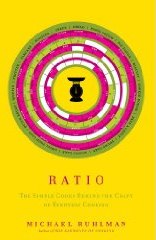Ratio: the simple codes behind the craft of everyday cooking
This book is important, not just because it will help you make dinner, but because it will help you understand dinner. We are emerging from the Bush era of mystical magical gibberish and have put upside-downism behind us. It’s no longer enough to do what we’re told. It’s no longer enough to believe that everything will be fine because we are Good People. It’s time for us to know what we’re doing.
Ruhlman argues that recipes are not enough; at best, having a recipe (and the necessary technique) lets you recreate a dish. You can cook it. If you like it, you can follow the instructions again. Instead, Ruhlman focuses on the key concepts that makes foods work; once you know these, you can make all sorts of things without fear.
Fear drives the cookbook business. The fear is: it won’t turn out. And, of course, if you just throw lots of stuff in a pot, like we used to do when we were six (and as clever as clever), it probably won’t turn out.
5 parts flour, 3 parts water: that’s bread. You need some yeast, but it doesn't really matter how much you add. You probably want some salt. You can add stuff: rosemary and caraway seeds, or almonds and raisins, or onion, or jalopeño peppers and dried tomatoes. You can change the shape. You can make a little, or a lot. Doesn’t matter. 5 parts flour, 3 parts water; it'll be bread.
I used to buy pancake mixes because it was so much bother to gather all the ingredients, measure them, and get the consistency right so the pancakes turned out. Sure, the Dancing Deer stuff it nice. But it’s not that hard. 2 flour:2 liquid:1 egg. An egg is 2 oz. So 6oz flour, 6oz milk, 1 egg. Throw in 1t of baking powder and 1/2t of baking soda. You can add some sugar if you like: maybe 3T. You can add some vanilla. You can add some blueberries. You can replace some of the milk with buttermilk or cottage cheese or sour cream. Want even fluffier pancakes? Separate the egg whites, whip them up, then add them to the rest. You can replace some of the flour with cornmeal or whole wheat or what you like. That's enough for 2. Need to cook for 8? 3c flour, 3c milk, 4 eggs.
It’s all like this. You can know this stuff. Nothing mystical, nothing magic, no weird rituals or procedures. Sometimes things don’t work. Ruhlman warns that mayonnaise smells fear. If your mayonnaise breaks, Ruhlman tells you how to whip it back into shape.
There’s lots of great stuff. How to make a great stock without making a big fuss. Or any fuss at all. How to whip up things like pie dough or cheese puffs off the top of your head. How to improvise a soup – any soup.
One missed opportunity is that paragon of fear, the souflée. Everyone knows that souflées are hard, dangerous, showy, and French. And Ruhlman has already covered the key ratio: bechamel for soups. The hidden trick about the souflée is: there is no trick. They’re like popovers: they just work. Alice Waters hits on this in The Art of Simple Food: the only thing that makes a souflée fall is cold air, and if your souflée does fall, pop it into a hot oven and it will poof again.
We’re seeing a second revolution in popular science in the US. The first was triggered by Sputnik, and led everyone to say, “the kids need science.” This time, in the wake of Bush and the Crash, we’re not leaving it to the kids. We want to know what we’re eating, we want to eat better, and we want to understand what we’re doing and why we’re doing it. Give us bread, and give us rosés.
